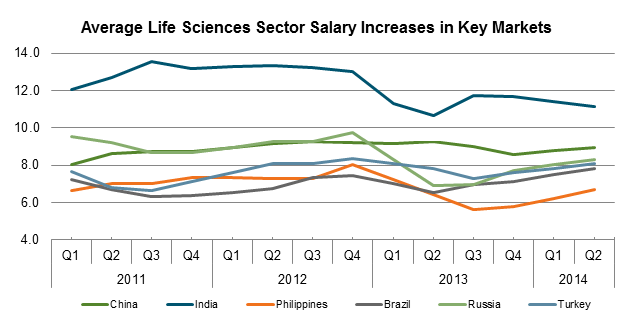Annual Salary Budgets: More Than Meets the Eye
- Published: August 2014
- Download
- Practice Areas: Managing Pay & Career Programs, Life Sciences, Global
Base salaries are often viewed as a matter of remuneration "hygiene" by corporate leaders. They know it represents the bulk of total pay for most employees, but it's not an area where they expect to see significant change from year to year. Nor is it an area where they typically attempt to drive meaningful differentiation across employee populations. As a result, many companies – especially those headquartered in stable markets like the United Kingdom – apply salary increase budgets evenly across their organization. It's understandable why companies adopt "across-the-board" methodologies for salary increases; however, we think it's time to take a more nuanced approach to setting base pay.
A False Sense of Stability
As the chart below illustrates, markets like the UK make it easy to believe base salaries progress at an extremely steady rate. After all, in the UK, this is true. And luckily, aside from an inflation spike in 2011, modest base salary increases in the UK life sciences sector (green trend line) have outpaced inflation since the start of 2012. The same is generally true for all life sciences workers in Western Europe (blue trend line), where base pay has changed within a tight range of 2.3% to 3.1% since the middle of 2010.

The same level of stability is observed in the United States, where average salary budgets for life sciences sector companies have barely strayed from 3.5% in each of the last four years.
However, the story changes dramatically when you begin to consider key emerging markets, as is the case in the chart below. In countries like China, India, the Philippines, Brazil, Russia and Turkey, base salaries are increasing at much faster rates than in developed economies and with higher degrees of volatility.
In India for example, life sciences sector salaries have increased at rates between 11.1% and 13.6% since the beginning of 2011. Interestingly, budgets in India are generally trending downward since the end of 2012. Meanwhile, salary increase budgets in other emerging markets are huddled between 6.0% and 10.0%, and are generally trending upward since the middle of 2013. As our data demonstrates, every emerging market is diverse and has its own story to tell.

Depending on the size of the employee populations where you operate, taking time to invest in distinct salary increase policies can make a lot of sense. In more volatile emerging markets, robust data is critical to effective salary budgeting, but it's just a starting point. Some companies adopt biannual or quarterly salary increase cycles to keep pace with the market, while other firms adopt streamlined performance review processes to ensure salary increases are effectively targeted to top performers.
Connecting Pay and Performance
Missing the mark on salary increase budgets carries significant risks, the most important of these being rising turnover among mid-level and top-performers who typically expect to be paid above market. However, even if you set annual salary budgets appropriately by country, turnover can still be a risk if budgets are not implemented correctly. This is especially true if budgets are spread evenly across employee populations without paying close enough attention to performance.
Salary increases, like bonus payouts and equity awards, are an opportunity for internal and external pay differentiation. Yet, this opportunity is often overlooked or handled poorly by frontline managers. Addressing this challenge can be accomplished in a number of ways, including:
- Increased training for managers on why it's important to avoid giving every employee the same performance rating and/or the same annual salary increase, a very common occurrence
- Creating guidelines for how to distribute annual salary increases within employee groups based on performance ratings or relative performance levels
- The development of robust salary increase tools to manage the process
- Setting aside special salary budget pools for top performers that human resources teams can apply as needed to high-value employees (in addition to promotion pools)
- Effective auditing processes to ensure that managers across countries and functions apply performance rating and salary budget guidelines consistently
Focusing on the task of effectively tying pay to performance during salary increase cycles is one of the best ways to introduce a broad-based pay-for-performance culture into your organization. It will also drive higher levels of engagement with performance review processes, even if reviews and salary adjustments occur at different times of the year. If employees see real links between performance conversations and pay, promotion and recognition outcomes, they will become more invested in those conversations.
To learn more about participating in a Radford survey, please contact our team. To speak with a member of our compensation consulting group, please write to consulting@radford.com.
Related Articles
- More Technology and Life Sciences Companies Are Turning to Market-Based Salary Structures
- New Overtime Rules are Almost Here; Understand Your Options
- Reliable Market Data is Critical in Wake of Massachusetts "Fair Pay" Law and Others Like It
- Senior Technical Jobs that Offer an Alternative to Management Tracks are Evolving
- Is it Time to Ditch Your Salary Structure for Market Pricing? We Debate the Pros and Cons.

